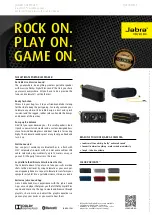
7
General
Antenna
The antenna for the radio is fitted to the unit
via a robust screw fitting to an M6 threaded
socket on the top of the radio. This system is
more rugged than a traditional BNC
connector, so the radio’s drop-proof integrity
is not compromised by the antenna fixing.
While the radio is drop-proof and very
robust, damage to the antenna such as
bending or kinking may adversely affect the
transmission efficiency of the unit, which
may lead to overloading of the power
module. Damaged antenna should be
replaced immediately.
30 m/
100 ft
Mast
9 m/
30 ft
Mast
87 km / 65 M
13-16 km
8-10 M
20 km / 12 M
8 km / 5 M
20-26 km / 12-16 M
46-53 km / 29-33 M
Cherbourg
Isle of Wight
Endeavour
Niton
Replacement antenna and other spare parts
can be purchased from your local reseller.
Please refer to section Spare Parts &
Accessories.
Transmission Range
Because VHF signals travel in a straight line
and are not reflected back off the iono-
sphere as lower frequency signals are, the
range of VHF signals is limited to ‘line of
sight’, beyond which the other vessel
passes behind the curve of the Earth.
Therefore, the range will increase greatly the
higher above sea level the antenna is, as
illustrated (assuming maximum transmission
power is used):
Therefore, the typical range of a hand-held
radio such as this one used at sea level will
be approximately 8 Km (5 Miles). This will
increase as height above sea level in-
creases, or if the other radio user’s antenna
is at a greater height - note that the range
between the yacht with the antenna
mounted on a 9 M (30 Ft) mast and the
hand-held user increases to 13-16 Km (8-10
Miles).
0438


































